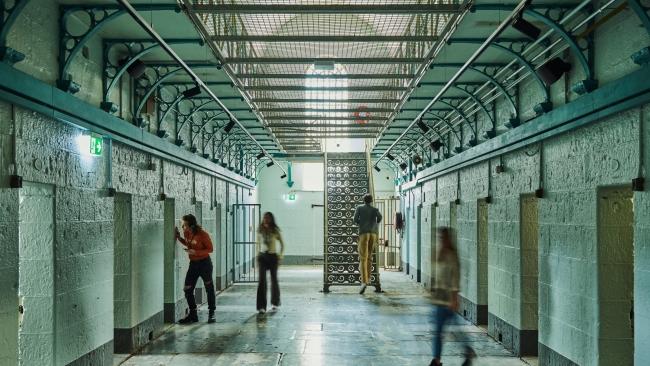Take a tour of Chopper Read’s old cell block
Once home to some of Australia’s most notorious criminals, Melbourne’s Pentridge Prison is open to the public.
Lifestyle
Don't miss out on the headlines from Lifestyle. Followed categories will be added to My News.
X marks the spot. But there’s no treasure hidden within the bluestone walls of Melbourne’s Pentridge Prison, only markers of human misery and despair.
A white cross marks the spot where condemned jailbreaker Ronald Ryan scaled the wall during his daring escape while an X shows where inmates stood in submission in the muster yard, the “baddest of the bad” prisoners corralled inside Pentridge’s infamous rock-breaking pens.
X is also a metaphor for the thousands of souls who served time at Pentridge during its almost 150 years in Melbourne’s northern suburbs. Their stories are told in situ, with the notorious prison now open to the public.
I was taken behind bars to preview the National Trust tours, which shine a light on the darkest corners of the heritage-listed complex – now a $1 billion urban hub, 10km from the CBD. It’s an incongruous mix of old and new. Where 19th-century buildings, once tinselled with barbed wire, stand shoulder to shoulder with a shopping centre, cinema, eateries and apartments.

Pentridge started as a rudimentary prison camp in 1851, when the goldrush heralded an influx of people – and crime. With Melbourne Gaol bursting at the seams, 16 inmates were marched north, building a wooden stockade that would mushroom into a bluestone fortress and house Victoria’s most dangerous criminals.
We “meet” some in B Division, a two-storey facility with four intersecting wings, designed for optimal surveillance and ventilation. The cells have been prettied up, but the stories have not. From former inmates, we hear tales of desperation and brutality. Of beatings, suicides, self-harm and rape. We learn about the panopticon, a cartwheel-shaped exercise yard with a central watchtower, where new inmates were brought, hooded, to “air” in a wedge of daylight for an hour a day – paltry respite from their dim isolation cells, designed to “reform through solitude and separation”.
It’s on the old panopticon wall where Ryan made his ill-fated jailbreak that would see a warder shot dead and him become the last prisoner executed in Australia. You can see the hangman’s noose and hear the chilling account of journalist Brian Morley, who witnessed the 1967 execution. “To see a man brought out and put to death while we watched – it was just the most unearthly feeling and horrible feeling that I’ve ever had.”
Stories are told through headsets, complemented by multimedia displays and artefacts (the cache of shivs and drug-smuggling contraband is especially eye-opening). Everyone loves a good escape story, and there are plenty, starting with bank robber Gregory Roberts, who shimmied over the wall in broad daylight, fled to India and penned a best-selling novel. Then there’s the tale of cop-killer William O’Meally, whose short-lived prison break via the front gate in 1957 earned him 12 lashes with the cat o’ nine tails and the notoriety of being the last person flogged in Australia.

O’Meally’s escape led to the establishment of H Division, or Hell Division, a 39-cell maximum-security block for the most dangerous prisoners. The roll call of inmates includes Mark “Chopper” Read, Hoddle Street massacre gunman Julian Knight and Russell Street bomber Stanley Taylor.
It’s a bleak place. The cells have been left almost untouched since the prison’s closure in 1997. The graffitied walls snarl with white-supremacist slogans and anti-police vitriol. When the bolt clangs shut on the prison gate, I can almost hear the inmates’ wails. I pause beneath the catwalk stairs where new arrivals, beaten and disrobed, were routinely handcuffed after receiving a “reception biff”.
In the cells, the walls speak of human depravity. It’s confronting listening, but at least I get to leave.
More Coverage
Originally published as Take a tour of Chopper Read’s old cell block




